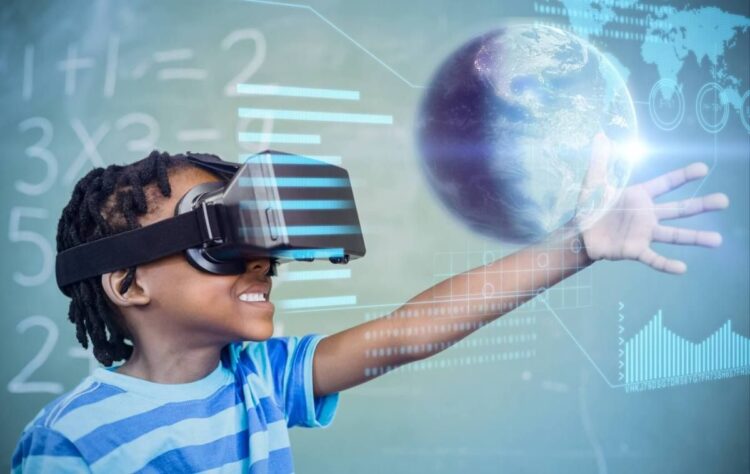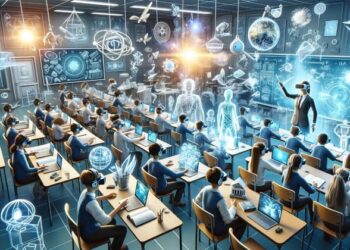In the past, education was confined to classrooms, textbooks, and lectures. Learning was often a passive process, relying heavily on memorization and abstract concepts. Today, however, we are at the dawn of a new era, where technology is not just supplementing education but fundamentally transforming it. At the forefront of this revolution is Virtual Reality (VR), a technology that promises to make learning an immersive, interactive, and deeply engaging experience. VR’s ability to transport students to any time, any place, or any environment is poised to break down the barriers of traditional learning, creating a more dynamic and effective educational landscape. This article will explore how VR is reshaping digital education, delving into its core applications, the significant benefits it offers to both students and educators, and the key challenges that must be overcome for it to achieve widespread adoption.
The shift to digital education, accelerated by recent global events, has highlighted both the potential and the limitations of conventional online learning. While platforms like Zoom and Google Classroom have made remote education possible, they often struggle to replicate the hands-on, collaborative, and experiential aspects of in-person learning. VR offers a solution by creating virtual spaces where students can interact with digital content in a three-dimensional, immersive environment. It allows a biology student to step inside a human cell, a history student to walk through ancient Rome, or an engineering student to dismantle and reassemble a complex machine, all without leaving their desk. This isn’t just a new way to present information; it’s a new way to learn, to experience, and to understand.
A. Core Applications of VR in Digital Education
The potential applications of VR in education are vast and diverse, spanning a wide range of subjects and learning styles.
A. Immersive Field Trips: Imagine a history class where students don’t just read about the pyramids of Giza, but can actually stand in front of them, exploring the intricate details and vast scale. VR makes this possible. It allows students to take virtual field trips to historical sites, distant planets, or even the depths of the ocean. These immersive experiences can provide a level of context and detail that is impossible to achieve with a textbook or a documentary. They transform abstract concepts into tangible, memorable experiences, making learning more impactful and retention higher.
B. Interactive Simulations and Hands-On Training: For subjects that require hands-on practice, like science, engineering, or medicine, VR offers a safe and cost-effective solution. Students can use VR to perform complex experiments without the risk or cost of real-world materials. A medical student can practice a surgical procedure on a virtual patient, an aviation student can learn to fly a plane in a realistic flight simulator, or a chemistry student can mix volatile chemicals in a virtual lab without the danger of explosions. This allows for unlimited practice and repetition, helping students master skills in a low-stakes environment before they move on to the real thing.
C. Creating a Virtual Classroom: VR can go beyond individual experiences to create a shared, collaborative learning environment. VR platforms allow students and teachers to gather in a virtual classroom where they can interact with each other and with 3D digital content. In this space, a teacher can pull up a 3D model of the solar system and have students manipulate it in real-time, or a group of students can collaborate on building a virtual structure, each contributing from their own home. This fosters a sense of presence and social connection that is often missing from traditional video conferencing.
B. The Benefits of VR in Education: Why It Works
VR is more than just a novelty; its effectiveness as a learning tool is backed by several key pedagogical principles.
A. Increased Engagement and Motivation: Traditional learning can often feel passive and boring. VR, by its very nature, is an active and engaging experience. The novelty and interactivity of the technology capture students’ attention and hold it, making them more motivated to learn. This increased engagement can lead to higher levels of participation and a more positive attitude towards a subject, particularly for topics that are traditionally difficult or abstract.
B. Deeper Understanding and Better Retention: When a student experiences a concept, rather than just reading about it, they are more likely to remember and understand it. VR allows for experiential learning, where concepts are learned through doing. A student who has virtually walked through the human heart will have a deeper understanding of its structure and function than one who has only looked at a diagram. This immersive and multi-sensory approach can lead to a significant increase in knowledge retention over time.
C. Personalized and Adaptive Learning: VR education can be highly personalized. VR systems can track a student’s progress and performance, adapting the learning experience to their individual needs. If a student is struggling with a concept, the system can provide additional exercises or change the way the information is presented. This adaptive approach ensures that each student learns at their own pace and receives the support they need to succeed.
C. The Challenges and Future of VR in Education
Despite its immense potential, VR’s widespread adoption in education faces several significant hurdles that must be addressed.
A. High Cost and Accessibility: The most immediate barrier is the high cost of VR hardware, including headsets and powerful computers. This can make the technology inaccessible for many schools and students, especially in underfunded communities. To achieve digital inclusion, the price of VR technology must come down, and educational institutions must invest in shared resources and infrastructure.

B. Technical Complexity and Content Creation: Implementing VR in a classroom requires technical expertise that many educators may not have. Furthermore, creating high-quality, educationally sound VR content is a complex and expensive process. There is a need for a robust ecosystem of educational VR content and user-friendly tools that allow teachers to create their own virtual learning experiences without being an expert programmer.
C. Health and Safety Concerns: Long-term use of VR can lead to issues like eye strain, motion sickness, and a disconnect from the real world. For younger students, there are also developmental and psychological concerns that need to be addressed. As VR becomes more common in schools, it will be crucial to establish clear guidelines for usage, including session limits and regular breaks.
In conclusion, Virtual Reality has the power to fundamentally transform digital education. It offers a new way of learning that is immersive, engaging, and deeply personal. By breaking down the barriers of physical space and allowing students to experience concepts in a hands-on, three-dimensional environment, VR can unlock a new level of understanding and creativity. While the path to widespread adoption is filled with challenges related to cost, accessibility, and content creation, the potential rewards are too great to ignore. VR is not just a tool; it is a vision for a future where education is not just about what we know, but about what we can experience.












